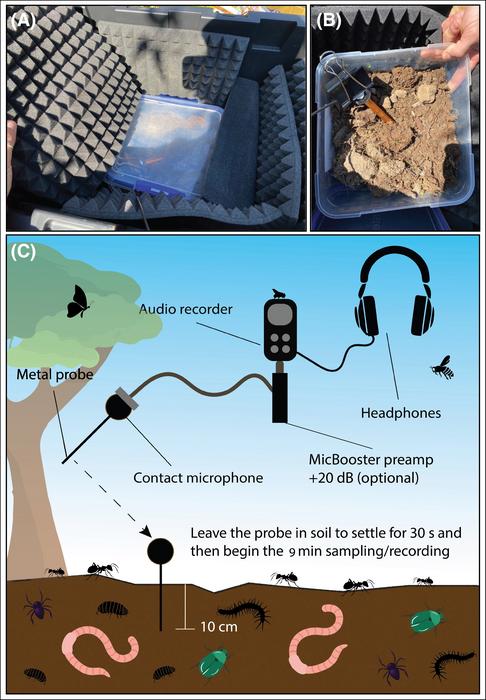Barely audible to human ears, healthy soils produce a cacophony of sounds in many forms – a bit like an underground rave concert of bubble pops and clicks.
Barely audible to human ears, healthy soils produce a cacophony of sounds in many forms – a bit like an underground rave concert of bubble pops and clicks.
Special recordings made by Flinders University ecologists in Australia show this chaotic mixture of soundscapes can be a measure of the diversity of tiny living animals in the soil, which create sounds as they move and interact with their environment.
With 75% of the world’s soils degraded, the future of the teeming community of living species that live underground face a dire future without restoration, says microbial ecologist Dr Jake Robinson, from the Frontiers of Restoration Ecology Lab in the College of Science and Engineering at Flinders University.
This new field of research aims to investigate the vast, teeming hidden ecosystems where almost 60% of the Earth’s species live, he says.
“Restoring and monitoring soil biodiversity has never been more important.
“Although still in its early stages, ‘eco-acoustics’ is emerging as a promising tool to detect and monitor soil biodiversity and has now been used in Australian bushland and other ecosystems in the UK.
“The acoustic complexity and diversity are significantly higher in revegetated and remnant plots than in cleared plots, both in-situ and in sound attenuation chambers.
“The acoustic complexity and diversity are also significantly associated with soil invertebrate abundance and richness.”
The latest study, including Flinders University expert Associate Professor Martin Breed and Professor Xin Sun from the Chinese Academy of Sciences, compared results from acoustic monitoring of remnant vegetation to degraded plots and land that was revegetated 15 years ago.
The passive acoustic monitoring used various tools and indices to measure soil biodiversity over five days in the Mount Bold region in the Adelaide Hills in South Australia. A below-ground sampling device and sound attenuation chamber were used to record soil invertebrate communities, which were also manually counted.
“It’s clear acoustic complexity and diversity of our samples are associated with soil invertebrate abundance – from earthworms, beetles to ants and spiders – and it seems to be a clear reflection of soil health,” says Dr Robinson.
“All living organisms produce sounds, and our preliminary results suggest different soil organisms make different sound profiles depending on their activity, shape, appendages and size.
“This technology holds promise in addressing the global need for more effective soil biodiversity monitoring methods to protect our planet’s most diverse ecosystems.”
The latest article – Sounds of the underground reflect soil biodiversity dynamics across a grassy woodland restoration chronosequence (2024) – by Jake M Robinson, Alex Taylor, Nicole Fickling, Xin Sun (Institute of Urban Environment, Chinese Academy of Science) and Martin F Breed has been published in the Journal of Applied Ecology (John Wiley & Sons on behalf of the British Ecological Society) DOI: 10.1111/1365-2664.14738.
https://besjournals.onlinelibrary.wiley.com/doi/10.1111/1365-2664.14738 weblink to go live 05:01am UK time 16 August 2024
https://drive.google.com/drive/folders/1znirkrKkPEcunX2pMaFiVIp5vyG9xvny?usp=sharing
Visual material available at the link (includes photos, audio clips and colour animation)
Journal
Journal of Applied Ecology
DOI
10.1111/1365-2664.14738
Method of Research
Observational study
Subject of Research
Animals
Article Title
Sounds of the underground reflect soil biodiversity dynamics across a grassy woodland restoration chronosequence
Article Publication Date
16-Aug-2024





